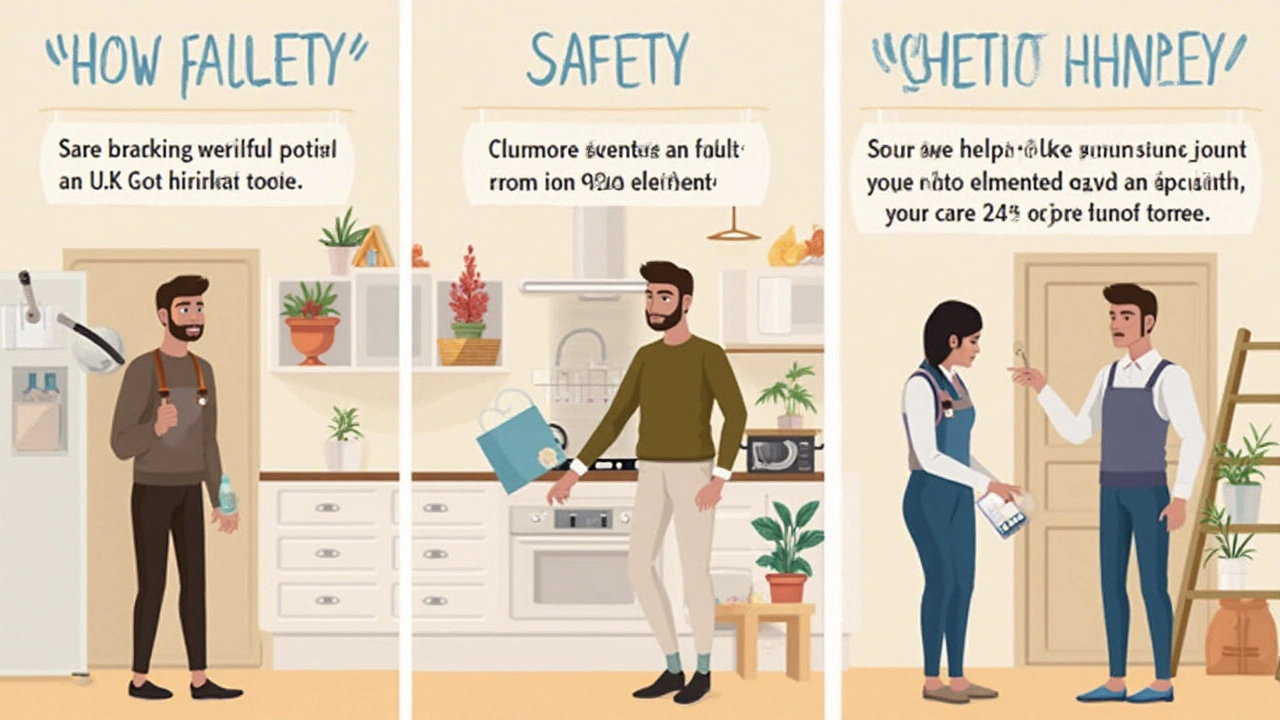Staring at your electric hob, annoyed because one ring just won’t heat up? Before you jump straight to calling in a repair guy or shelling out for a new appliance, know that it’s often possible to swap out a dodgy element yourself — if you’re up for it. This isn’t some wild technical task, but it’s definitely not just like changing a lightbulb, either.
First up, safety isn’t optional. Always unplug your hob or kill the power at the fuse box. Touching the wrong bit with live electricity running through it can end badly — we’re talking possible electric shock, not just a short trip to frustration city. So double-check: no power, no drama.
Most people think they need a brand new cooker if a hob ring packs up. Actually, those elements wear out from heat and age, and replacing them can breathe new life into your hob for much less money. The tricky part is making sure the problem really is the element and not a dodgy switch or wiring fault, which might look similar at first.
- How Do You Know the Element Needs Replacing?
- What's Involved in Replacing a Hob Element?
- Common Mistakes and How to Avoid Them
- When Should You Call a Professional?
How Do You Know the Element Needs Replacing?
If you’re wondering why your electric hob is acting up, it’s easy to jump to the worst worry. But there are clear signs when a hob element is on its way out, and being able to spot these can save you guessing (and money). A lot of common issues come back to a failed element, but not every heating glitch means you need a new one.
Here are some dead giveaways that you should consider swapping your element:
- The ring won’t heat up at all, even when switched to full power.
- The element gets hot in only one spot or has cold patches.
- It takes way longer than usual to heat up your pan.
- You see obvious scorching, blisters, or cracks on the hob surface right over the problem area.
- There’s a burning smell that comes up every time you turn that ring on, but the others are fine.
Sometimes, though, the issue is more subtle. Maybe the temperature control is iffy, making it impossible to simmer without boiling over. Or you hear buzzing or clicking noises that weren’t there before. These can also suggest problems with the element, but could be a sign of switch or wiring trouble.
If you want to double-check before buying a replacement, you can test the element with a multimeter. Set it to measure resistance (ohms), turn off the power, and pop the hob open. If you get a reading of zero (short circuit) or infinity (element broken), it’s probably time for a replacement.
| Sign | What It Usually Means |
|---|---|
| No heat from element | Element likely burned out |
| Heats unevenly | Element damaged or breaking down |
| Blisters or black marks | Element overheated, needs swapping |
| Burning smell | Insulation or element itself gone bad |
Don’t forget: lots of electric hob faults can look like an element issue but actually be down to the control switch or even dud wiring. Before you replace anything, try swapping pans and moving to a different ring to see if the problem follows. If everything else works but one ring never heats, it’s usually the electric hob element at fault.
What's Involved in Replacing a Hob Element?
If you’ve decided to fix your electric hob yourself, here’s the honest truth: it’s not rocket science, but there are some steps that matter. First, figure out what kind of hob you have. Solid-plate and ceramic hobs are the most common. Elements in ceramic hobs sit under the glass while solid-plate hobs have visible metal rings.
You’ll need a few basic tools: a screwdriver, some needle-nose pliers, and a replacement element that matches your exact hob model. Getting the wrong part is a classic mistake—always double-check the model and serial number, usually found on a badge under the hob or inside the manual.
- Turn off the power at the fuse box—never skip this step.
- Remove the hob from your worktop. For built-ins, you’ll probably need to loosen a few screws holding it in place.
- Carefully lift the hob. Don’t tug the cables underneath; some might still be attached to your worktop or control panel.
- Open up the case or the underside, which usually means taking off a metal plate held by screws.
- Spot the faulty element (the burnt or cracked one, usually obvious).
- Take a clear photo of the wiring before disconnecting anything. This is a lifesaver when it’s time to reconnect the new element.
- Disconnect the wires from the faulty element. Some are push-on spade connectors, others are screw terminals.
- Swap the old element for the new one and reattach the wires as they were.
- Before putting the hob back, check the connections are tight and tidy—loose wires are a top cause of faults or even fires.
- Test the setup by restoring power and turning on the repaired ring for a minute. Turn power off again if you need to reassemble any panels or screw the hob back into place.
Don’t forget to recycle the old element responsibly—local electrical waste collection points usually take these. If you get stuck, some manufacturers put step-by-step diagrams in the manual or on their website, which can make the job a lot easier. And if anything feels over your head, no shame in calling a pro.
When it comes to electric hob fixes, planning ahead makes all the difference between a quick win and a frustrating afternoon.

Common Mistakes and How to Avoid Them
Trying to fix an electric hob isn’t rocket science, but a few mistakes can make the job a lot tougher than it needs to be—or even dangerous. Let's get straight to what usually trips people up and how you can sidestep the hassle.
- Mixing up wires: It sounds obvious, but lots of people forget to take a photo or to draw a quick sketch before disconnecting the wires from the old element. If you reconnect things wrong, you’re asking for sparks or a dead hob. A photo on your phone sorts this in seconds.
- Not double-checking power is off: Just flipping the switch on the hob itself isn’t enough. You need to turn off the power at the breaker or fuse box and physically check that nothing is live before you touch anything inside. This step is non-negotiable.
- Using the wrong part: Not all hob elements are the same. People often snap up the first part that looks vaguely right online, but there are small differences in size, power rating, and connections. Always match the model number and specs. If you get this wrong, the ring might overheat, underperform, or simply not work at all.
- Skimping on cleaning: Grease or food can sneak into places you don’t notice. If you install a new element without wiping down beneath the hob, old grime can cause burning smells or even electrical arcing. It’s gross, and it’s avoidable.
Fumbling any of these can turn a quick fix into a longer headache—or a safety issue. Here’s a quick view on what most DIYers mess up and what it causes:
| Mistake | What Usually Happens |
|---|---|
| Wrong wiring | Hob won’t heat, may trip circuit, or create a fire risk |
| Forgot to cut the power | Electric shock, sometimes serious injury |
| Incorrect part | Element doesn’t fit, overheats, or fails fast |
| No cleaning | Burning smells, possible arcing, shorter part life |
A last tip: Always check your appliance warranty before you rip anything open. Some brands void the warranty as soon as you start poking around—so you might be better off with a pro if your hob’s still covered.
When Should You Call a Professional?
Thinking about swapping out that electric hob element yourself? Sometimes, it’s just not worth the risk or hassle. If you’re not sure what’s wrong, or if there’s more to the issue than a single cold ring, bringing in a pro can save you serious stress down the road.
Here’s when you definitely want to hand over the screwdriver:
- You see scorch marks, melted wires, or burnt smells. These signs may mean hidden electrical damage—not just a bad element.
- The power keeps tripping, even after unplugging the hob. This often points to a bigger wiring problem inside the appliance—or even your home’s electrics.
- Touch-sensitive or digital controls are acting weird. Modern hobs can have complicated circuit boards and sensors; that’s not beginner territory.
- You hear buzzing or popping noises when the hob is on. That’s never normal and could be risky to poke around with.
- Your hob is still under warranty. Messing with it yourself could void the warranty. Check those terms before doing any DIY.
It's not just about the fix—most pros hold special certifications that prove they know what they’re doing. In the UK, for example, electricians are often registered with NICEIC or a similar group, guaranteeing decent safety standards. Plus, an experienced appliance engineer will usually sort things faster, with less faff.
Worried about cost? Here’s a quick look at typical prices for professional repairs versus DIY:
| Repair Option | Average Cost (GBP) | Time Needed |
|---|---|---|
| Pro Repair (hob element) | £70-£120 | 30-60 minutes |
| DIY (element only) | £15-£40 | Varies (can be 1-2 hours or more) |
| Full Hob Replacement | £200-£500+ | Depends (includes fitting) |
Remember, insurance companies might not cover self-inflicted kitchen disasters—if you damage something while attempting a repair, you could end up footing an even bigger bill. If in doubt, get an expert. A quick call could cost less than a new appliance—and you keep your peace of mind.

I am an expert in the services industry with a focus on appliance repair. My passion lies in understanding how things work and educating others in simple, engaging ways. This enthusiasm fuels my writing, where I delve into topics around appliance maintenance and troubleshooting. I aim to make these subjects clear and accessible to all readers.